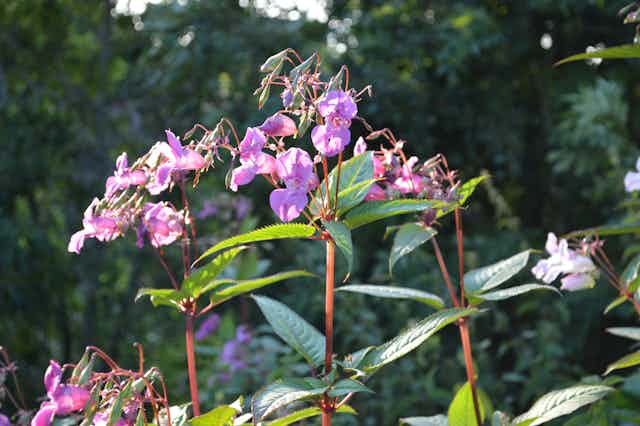From lochs and lakes to rivers, ponds and canals, there is a diverse range of freshwater habitats in the UK, which is good news not just for biodiversity but also the economy, where they are collectively valued at £39.5 billion. Rivers in particular are highly biologically diverse environments, home to a wide variety of plants, invertebrates and fish. But linked together within a river catchment, they are prone to invasion by alien species that can spread quickly between these interconnected habitats.
Invasive alien plant species are of one of the biggest concerns to river environments. These contribute to the loss of native plants and invertebrates, as well as altering soil chemistry and impeding river flow. It costs the UK government around £1.7 billion to control invasive alien species and an estimated £6m alone to control the well-known troublesome Japanese knotweed (Fallopia japonica).
Read more: Invasive plants have a much bigger impact than we imagine
Himalayan balsam (Impatiens glandulifera) is an alien plant from the Himalayas introduced to Britain in 1839 by Victorian botanists, and is a prominent and familiar sight along UK waterways. Growing to up to a colossal four metres tall, this annual plant is a serious competitor to native British plants.
Himalayan balsam is listed on Schedule 9 of the Wildlife and Countryside Act in England and Wales which makes it an offence to plant or allow the species to grow in the wild. However, Himalayan balsam is so widespread it is increasingly challenging to tackle.
Strategies for managing this species involve prevention (such as awareness campaigns and enforcing legislation to prohibit entry or spread), complete removal of the species (generally not feasible within river habitats due to their interconnected nature), and control (such pulling up individual Himalayan balsam plants prior to seeding). The most effective method of control so far, particularly for Japanese knotweed, is herbicide spraying. However, there are collateral risks to water quality and aquatic animals and plants from herbicide run-off when these plants are close to waterways.

Taking on the aliens
The classic signs of invasion by Himalayan balsam is a wall of vivid pink flowers and a sickly sweet smell along river banks. Most sites we have studied have been invaded for over ten years, but curiously often neighbour an almost completely green length of the same river bank. What is it about these uninvaded areas along a river that makes them immune to this alien species? If we can understand the conditions which promote or deter the pink wall, the information could be used to manage these Himalayan balsam populations.
The local environment, as well as the native plant community, determines whether an invader can establish, and thereafter expand its population. Competition between plant species for resources such as space and light is brutal. It’s a battleground out there, and not all species can win. Common native plants, such as the stinging nettle, butterbur and canary reed grass, can be direct competitors of Himalayan balsam.
A study we conducted aimed to untangle the direct and indirect effects of the environment and competition on the abundance of Himalayan balsam along rivers. We surveyed sites along rivers across Scotland which varied in environmental conditions, such as the number of river flood events per year. These rivers also had areas along the bank that were heavily invaded by Himalayan balsam, close to an area which had more dominant native species and no invasion.
Compared to native plants such as common reed grasses that dominate lowland riverbanks, Himalayan balsam dislikes overly moist conditions. Instead this plant prefers drier, steeper riverbanks where it can compete more effectively with native plants. A river inundated by flood water is therefore not ideal habitat for this invader, but native dominant species accustomed to occasional waterlogging are less negatively affected. This knowledge provides us with vital information to manage Himalayan balsam indirectly, by manipulating conditions on riverbanks, such as making them less steep so that they retain more water, which Himalayan balsam dislikes.

Unfortunately, river engineering practices often involve straightening and over deepening rivers. Combined with abstracting water for agriculture, this leads to drier riverbanks during the summer, which benefits Himalayan balsam. In contrast, the restoration of rivers often strives to create gently shelving riverbanks and a more sinuous channel. This means that water is retained, riverbanks are moister and native species are favoured at the expense of Himalayan balsam.
In 2018 Britain experienced one of its hottest, driest summers. Changing climate is likely to provide conditions which enable invasive alien plants to thrive along rivers. Hence, managing species in light of their environmental preferences is so important. Our study showed that a large abundance of dominant native plant species are more able to resist invasion by Himalayan balsam. So there has never been a better time to embrace our native species, even a river bank favourite such as the humble stinging nettle.

